The Zanzibar slave market is the last thing on your mind when you think of this island paradise. Yet it can only be found a short distance from Zanzibar's white palm-fringed beaches and luxury hotels. The memory of the slave market serves as a sinister reminder of a very dark period for mankind.
For such a small island, Zanzibar (Uguja) has a lot of history. This is due to its position at the intersection of Africa, the Middle East and Asia. Therefore, it has long been a center that connects East Africa and the outside world. It was once the center of the slave trade in the Indian Ocean, dominated by Arab slave traders.
The slave trade moved to East Africa after the British Parliament voted to end the West African slave trade. Suddenly, East African prisoners became a coveted commodity. Slaves were generally of different ethnicity, race, religion or nationality. The slave trade took these Africans away from their roots.
During this period, there was a conscious effort by the slave owners to remove the slaves' identities. Often they boarded a slave ship naked, without possessions from their past lives. Their customs, beliefs, songs, stories and languages were all they had with them.

Zanzibar's story
Early trade routes
Zanzibar has been inhabited for 20,000 1 years. Arab, Indian and Somali traders visited Zanzibar already at XNUMX. century AD They used the monsoon winds to sail across the Indian Ocean. Once there, they landed at the sheltered harbor located on the site where Stone Town now stands. Stone Town did not lack fresh water. It was therefore a good point to shop with cities on the Swahili coast.

Zanzibar was also part of a major trade route from the Roman Empire to the Asian ports. Although the island had nothing the merchants wanted, it offered a good place to make contact and trade with the East Africans.
Traders began to settle in small numbers on Zanzibar in the late 11th or 12th century, and married indigenous Africans. They built garrisons on the island and brought with them the Islamic religion. As a result, the first mosque in the region was built by Yemenis. Through marriage, the Kiswahili language was born, which formed the basis of today's Swahili.
Portuguese rule
Zanzibar's spice trade history began in the late 15th century. This was when the first Portuguese traders brought nutmeg, cinnamon and other spices from the colonies of India and South America. The plantations flourished under the ideal conditions on the Swahili coast.
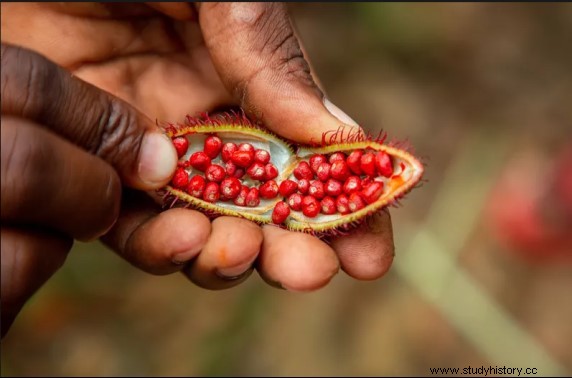
Around the year 1503, Zanzibar became part of the Portuguese Empire and remained under their responsibility for almost two centuries. During this period, African resources were utilized to the maximum. For example, slaves and ivory were exchanged for simple things like mirrors.
Zanzibar sultanate
The Arab slave trade precedes Islam and lasted over a millennium. In 1698, Zanzibar became a protectorate in Oman. Then flourished trade in slaves and ivory and a plantation economy based on cloves. A powerful and rich class of people appeared along the coast as a result of their participation in trade. Omani aristocrats seized the most fertile land and enslaved the African peasants who did so.
The height of Arab rule was when Sultan al-Busaid moved the capital from Muscat in Oman to Stone Town in 1840. He established a ruling Arab elite and encouraged the development of spice plantations using the island's slave labor. At this time, Zanzibar was known worldwide for its spices and slaves. During the 19th century, it was described by an explorer as "the land of spices, a disgraceful center of slavery and the place of origin of expeditions to the vast, mysterious continent". The island embodied all these things.
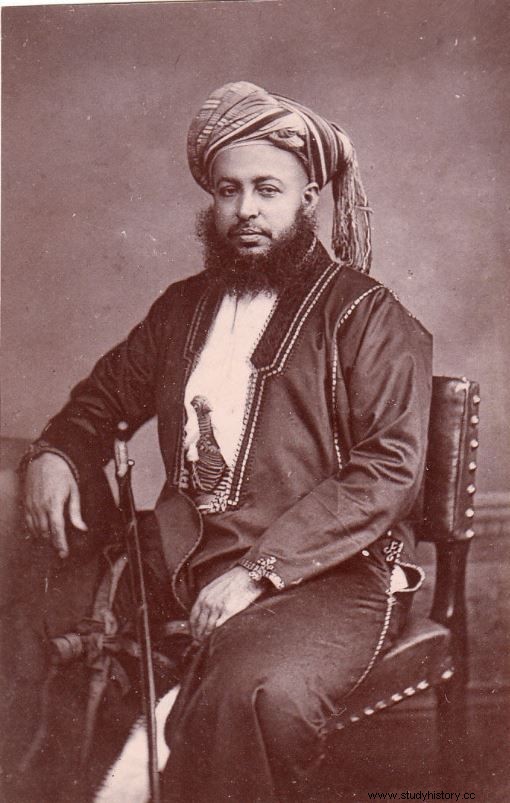
British control
The British interest in Zanzibar was motivated by both trade and the determination to end the slave trade. Under strong British pressure, the slave trade was officially abolished in 1876, but slavery itself remained legal on Zanzibar until 1897. In 1890, Zanzibar became a British protectorate. The death of one sultan and the succession of another, which the British did not approve, later led to the Anglo-Zanzibar War in 1896, also known as the shortest war in history.
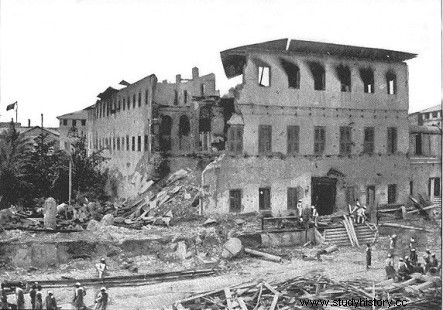
Zanzibar's slave trade
Profitable
Of all forms of economic activity in Zanzibar, slavery was the most profitable. Therefore, around 40,000 50,000 to XNUMX XNUMX slaves were brought to Zanzibar each year by crowded dhows from the Great Lakes. The vast majority of black slaves on the island were either brought from East Africa or descendants of slaves from East Africa.
The newly acquired slaves were often forced to carry ivory and other goods back to Bagamoyo. The name Bagamoyo is derived from the Kiswahili words bwaga moyo which means "put down your heart". This was the point where slaves abandoned any remaining hope of freedom or flight.
In the mid-19th century, the streets of Zanzibar were full of slaves. About a third were brought in to work on the spice plantations in Zanzibar and Pemba. The rest were in transit to Persia, Arabia, the Ottoman Empire and Egypt. The plantation owners were concerned with keeping the ethnic groups apart. This gave them less opportunity to plot against the owners.
Loss of identity
The slaves on a ship were not from one place or ethnic group. They were a mixed group, bought from different places around the east coast of Africa. They had different cultures and spoke different languages.
The slave owners tried to destroy the slaves' African identity. They were often given new names and old customs were discouraged. Religion was a frequently used tool used in the slave trade. Reverse slaves were treated better and had less chance of being redeemed. However, this meant that they had to sacrifice their traditions and customs.

Slaves came to dominate the population, making up about two-thirds of the island. The culture of slavery became so ingrained in society that slaves who earned wages bought slaves or invested in slavery. Although the slave trade was abolished in 1873, slavery continued as an institution in Zanzibar until 1909.
Zanzibar's slave market
Although the slave trade took place all over the island, there were three large markets. The slave market in Stone Town was notorious for being the most brutal.
When they reached Zanzibar, slaves were cleansed and their bodies covered with coconut oil. They were forced to wear gold and silver bracelets with the name of the slave trader. At that time, slaves were forced to line up along the streets guarded by loyal slaves carrying swords or spears. The slave market in Stone Town opened around four in the afternoon. The slaves were arranged in rows according to age, sex, suitability for work or value.

Buyers would examine the mouth and teeth and all body parts. After this, they were forced to walk or run to show that they had no faults. If the price was agreed, they were deprived of the finesse and delivered to their future master.
Living conditions
I route
Prisoners were crammed into crowded dhows with almost no food or water. It was estimated by Dr. Livingstone that for every 50,000 who arrived in Zanzibar, 80,000 died along the way. For those who succeeded, a new trial awaited.

The Slave Cellars
Zanzibar's slave market tour guides tell horror stories from these times. Next to the Zanzibar Slave Market Memorial are the old slave cellars under St Monica's hostel. Slaves were kept there before being brought to market for auction.
The cellars were almost devoid of air and light, and new slaves did not receive food for 3 days. This was to see if they were tough enough to survive. Upon release, they were tied to a pole and whipped in a new test. The value of slaves in Zanzibar was often based on how much pain they could endure in that post.
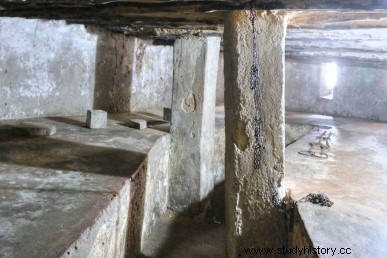
Two of the 15 slave cellars are open to the public to see. The slave cellars consist of small spaces underground where up to 65 men, women and children would be held for several days before the auction. There was originally only one small window at the end of the basement; the others are a recent addition. There were no toilets and dead bodies were thrown in the opening between the shelves.
Auction
If slaves survived this treatment and were sold, they would probably be sent to different Arab countries. For those sold to the plantations, life was so hard that about 30% of the male slaves died each year. This meant that a different amount of slaves had to be imported.
The Omani Arabs who ruled Zanzibar were known to be violent and viewed cruelty as a virtue. Visitors to Zanzibar often mentioned the "shocking brutality" that the Arab masters treated their African slaves. Masters deliberately terrorized the slaves through whipping, family segregation and rape in an attempt to control them. Because of this, they were so cowed to submission that a slave revolt was never attempted.
The1964 Uprising
The massacres in 1964 on Zanzibar highlighted the long-standing problems between the Arabs and the Africans on the island. The cruelty with which the Arab masters treated their black slaves left a legacy of hatred that exploded. At least 80 were killed and 200 wounded during the revolution (the majority were Arabs). Up to 20,000 XNUMX civilians were killed in the wake.
Memorials
Today, Stone Town is a UNESCO World Heritage Site. The Zanzibar slave market monument was unveiled in 1998 as a reminder of the island's bad history.
Monument
The Zanzibar slave market monument shows five slave figures chained together in a pit. The chains are real historical objects. There are men and women, young and old, with features that show a variety of tribal and ethnic backgrounds. The pit is located in the same place where slavery was collected for sale.

The Anglican Church
Near this monument is an Anglican church that was built over the area where slaves were brutalized. A circle of white stones at the altar marks the place where the whip post once stood. An outer circle of red stones represents the bloodshed that took place. Copper panels behind the altar show various figures from the Old Testament. The walls of the church are full of memorial plaques to honor the missionaries who died while serving in Zanzibar.
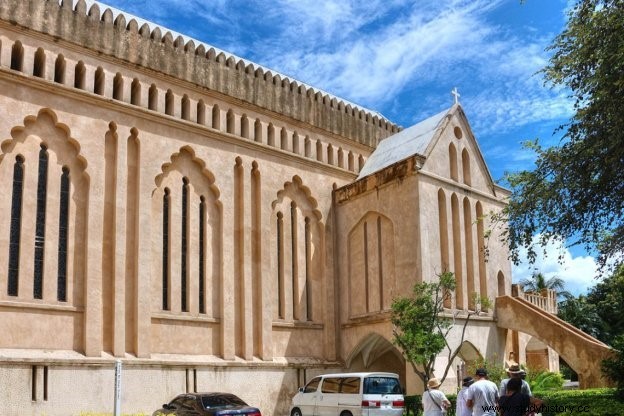
Exhibition Center
Outside the church is the Zanzibar Slave Market Memorial. The ground floor of St Monica's hostel houses this exhibition which provides a detailed history of the island's slave history.

One of the most heartbreaking stories must be the one about Cypriani Asmani who was a slave child in Zanzibar. When he was about 6 years old, he tried to run away. As a result, he was chained to a log that weighed more than 32 kg for punishment. Consequently, Cypriani could only move by wearing it on his head. He had been linked to the log for more than a year when a missionary rescued him in July 1895.
Relevance for the present
Finally, the Zanzibar Slave Memorial serves as a reminder to the world that it needs to learn from the past. As a result of slavery, Africa became poor again by depopulation and plunder of gold, ivory and other resources.
With the weapons brought to Africa, some kingdoms had an advantage over others and enjoyed raiding for slaves. Existing alliances were destroyed for weapons and wealth. As a result, the negative impact on African societies can still be seen.
Today, identity theft and racism caused by slavery are a pervasive social problem. If not for slavery, Africans may have had a better chance of equality today. Consequently, they would not have lost their homeland, culture and identity. The long-term effects are still visible in how these people think, where they live, how much money they have, and even how they want to look.
References
Atlas Obscura. 2021. Memorial Market for the Slave Market. Retrieved from:https://www.atlasobscura.com/places/slave-market-memorial
Fay, R. 2005. Swahili people. African American Studies Center . Oxford University Press.
Grabmeier, J. 2010. Research reveals massive extent of slavery between Muslims, Christians for three centuries. Ohio State University.
Ingrams, WH. 1967. Zanzibar, its history and people , Routledge.
Natania Travel. 2020. Slave Market on Zanzibar . Retrieved from:https://nataniatravel.com/en/the-slave-market-zanzibar-island/
Petterson, D. 2002 Revolution in Zanzibar:An American's Cold War Tale . New York:Westview.
Port Cities Bristol. Nd Bristol and transatlantic slavery. Retrieved from:https://www.discoveringbristol.org.uk/slavery/after-slavery/wider-world/african-diaspora/identity-and-roots/
Rachael. 2017. Zanzibar Slave Market:A Solemn Piece of History. Retrieved from:https://www.safari254.com/zanzibar-slave-market-a-solemn-piece-of-history/
Sinclair, P, Abdurahman, J &Felix, C. 2006. The African Archeology Network:Research in progress . There is Salaam University Press.
Zanzibar packages. Nd slavery on Zanzibar. Retrieved from:http://www.zanzibarpackage.com/slavery-zanzibar
